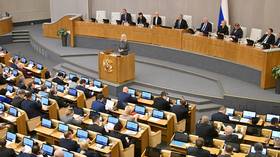Sinn Fein’s historic breakthrough is a long-overdue rejection of the status quo and a cosy two-party system

It’s been described as “seismic,” a “tsunami,” a “monsoon.” Whatever you call it, Ireland has witnessed a political earthquake, with long-time outcast Sinn Fein stunning the establishment to become the island’s most popular party.
By winning the popular vote, the left-wing Sinn Fein (SF), long hampered by its historic associations with the IRA and the violent struggle against the British state in Northern Ireland, has managed to pull off a feat no other political party has in almost a century.
To an outsider unfamiliar with the finer details of Irish politics, the numbers themselves may not seem so significant: SF won the popular vote with 24.5 percent, while the two center-right establishment parties, Fianna Fail (FF) and Fine Gael (FG), won 22.2 and 20.9 percent respectively. Only when you put it in its historical context does the significance of the SF rise become clear.
Also on rt.com BBC journalist sparks anger online after ‘populist’ jibe in wake of historic success for Sinn Féin in Irish electionsUnder Ireland’s proportional representation voting system, first preference votes for SF were a miniscule 1.9 percent in 1987. A decade later in 1997, that figure had grown to a measly 2.5 percent. By 2016, it rose to 13.8 percent, but the party was still seen as politically insignificant. Four years later and under new leadership, SF has managed to become the most popular party in the country and, finally, broke Ireland’s two-party system.
Anti-Sinn Fein media bias
This was a day many never believed would come. It was only 26 years ago, before the signing of the Good Friday Agreement, that Sinn Fein representatives were still banned from the airwaves in Ireland under ‘Section 31’ of the Broadcasting Authority Act. On Sunday, there was an international media scrum to get a word from 50-year-old party leader Mary Lou McDonald, whose middle-class South Dublin upbringing sets her far apart from the image of the balaclava-clad IRA men of the past.
RTÉ used Section 31 to censor interviews with Sinn Féin until 1994.Today.... #SinnFein#Votapic.twitter.com/xP4vtm9AoB
— Piarais Mac Alastair (@piarais91) February 9, 2020
This evolution did not come easily. Twenty-two years on from the peace agreement, a deep-seated anti-SF bias still permeates much of Ireland’s media. The party is relentlessly and combatively questioned on its past. Its left-wing economic policies and promises to impose higher taxes on the rich (unsurprisingly) don’t go down too well with the lavishly remunerated presenters at Ireland’s state broadcaster, RTE.
Ireland’s Virgin One channel refused to invite McDonald to its first pre-election leaders’ debate. Scandalously, RTE also attempted to block her from its own leaders’ debate, eventually backtracking in the face of public backlash as SF shot to first place in the polls – and a survey on the widely read (but left-leaning) news website, The Journal, found 82.3 percent believed she should be on the debate stage.
Meanwhile, the old guard of FF and FG consistently vowed that they would never enter into a coalition with SF. Saturday’s results saw FF leader Micheal Martin quickly change his tune. With his eyes on the prize of the Taoiseach’s (PM’s) office, Martin instantly softened his anti-SF stance.
Also on rt.com ‘Save the union’? Boris Johnson REALLY wants to build a billions-worth bridge to N. Ireland as critics scold ‘vanity project’Brexit and ‘nationalism’
By Sunday, many Irish pundits were desperately rushing to frame SF’s success as a “protest” vote, not signalling real change. In Britain, where commentary on Ireland is generally dismal and almost always misses the mark, there has been a knee-jerk reaction to frame the result as being driven by Brexit. In the US, a piece in The Atlantic declared that SF’s surge points to “rising nationalism” and compared the result to the election of Donald Trump.
SF is often described as a “nationalist” party. In a wider European context, the word “nationalist” immediately conjures images of anti-immigrant, far-right movements – but in an Irish context, the word is rooted in anti-colonialism and almost entirely restricted to a belief in north-south reunification and an Ireland free from British influence.
Attempts to establish right-wing nativist politics as a force in Ireland look to have flopped again, as only 1% of 5,300 voters polled say immigration was an important factor in deciding how to vote. pic.twitter.com/6JZOCTv8KL
— Naomi O'Leary (@NaomiOhReally) February 9, 2020
In fact, the election’s exit poll showed ‘Brexit’ and ‘immigration’ were at the bottom of the list of issues guiding voters’ choices (one percent). At the top were healthcare (32 percent) and housing and homelessness (26 percent).
‘Youthquake’ and united Ireland?
SF was the choice for 30.8 percent of voters aged 18-24. Taking a broader look, the party is now the most popular with all voting groups under the age of 65. The direction of travel in Irish politics for the moment is undeniably left – and scaremongering about SF’s past no longer seems to be a winning strategy for establishment parties and mainstream media.
Interestingly, the exit poll also showed 75 percent of 18-24 year-olds want to see a referendum on Irish unity within five years (57% overall). While unity was not a driving issue in the campaign, polls in the Republic have consistently shown a solid majority in favour of reunification – and with Scotland itching for a second independence referendum, it’s no wonder British media are throwing their toys out of the pram and fearing an eventual break-up of the UK.
Ireland’s youth have been energized by recent referendums ending an abortion ban and legalizing same-sex marriage – and it’s probably safe to say interest in Sinn Fein among young people was at least partly driven by the prominent role the affable McDonald played in those campaigns. Yet, more than anything, it was driven by the disastrous failure of previous governments to offer them any hope for the future. With a lack of affordable housing, extortionate rents and a crisis in public healthcare, people are increasingly eager to see a government that includes neither FG or FF.
This is a pretty staggering graphic showing the SF surge across the entire country via @fionamitchell56#GE2020pic.twitter.com/fFH7UhnM5m
— Colette Browne (@colettebrowne) February 10, 2020
The wrangling has now begun to decide which parties will make up the next government. It will be no easy negotiation. On the basis of seat count, we may see McDonald enter into an uncomfortable political marriage with FF. She says it “may well” be possible for her to become the first female Taoiseach.
In the wildest dreams of Ireland’s Left, McDonald would lead a broad left-wing coalition – though the current numbers make that very difficult. If not now, maybe next time. Of course, there’s always the chance that if no workable government can be agreed, ‘next time’ may not be that far off.
Whatever the outcome in the coming weeks, this election was a slap in the face to Ireland’s establishment – and not a moment too soon.
Like this story? Share it with a friend!
The statements, views and opinions expressed in this column are solely those of the author and do not necessarily represent those of RT.















